5K walk for mental health awareness
September 16, 2010
Take time Saturday, October 2 to participate in the 7th Annual NAMIWalks for Los Angeles County. The not-too-taxing 5K (three-mile) exercise and fundraising event for the National Alliance on Mental Illness promotes public awareness, and aims to erase stigma and support community programs to improve mental health.
Rechristened as NAMI’s “Walk for the Mind of America,” this year’s event promises to be bigger than ever. Hundreds of individuals, divided into more than150 teams, have already signed up.
Things get started on Santa Monica’s Third Street Promenade with an 8 am check-in, and following the preliminaries, walkers will set off at 9:30 am. For further information, check out the NAMIWalks website or contact Wayne Baldaro. Walk on!
Posted 9-16-10
Hike Saturday under the oaks
September 16, 2010
Mighty oaks from little acorns grow, the proverb says. On Saturday, September 18, 2010, you’ll have your own opportunity to meet a mighty oak, nowhere more important the world over than here in California. These magnificent trees are the stuff of legend, and an integral part of our state’s fragile ecosystem.
Beginning at 6 p.m., the Santa Monica Mountains Conservancy will host an evening nature walk commencing from the front parking lot of Temescal Gateway Park–a moderate two-hour hike over 1.5 miles to make the acquaintance of these gentle arboreal giants. The hike is free, but parking is $7; wear sturdy shoes, don’t leave the trail, and remember your water, flashlight and jacket.
Temescal Gateway Park is located at 15601 W Sunset Blvd. in Pacific Palisades; the website provides directions and full details.
Posted 9/16/10
Why we all need to slow down for Julia
September 15, 2010
Jody Siegler lost her 13-year-old daughter—and found, “in the midst of all this pain and despair,” a path to action.
On Thursday morning, that path will lead her back to the corner of Sunset Boulevard and Cliffwood Drive in Brentwood—back to where her daughter Julia, an 8th-grader at Harvard-Westlake, was run over as she crossed the street to board her school bus.
There, Jody Cukier Seigler will step into her own as an activist, determined to make the world a safer place, one intersection at a time.
Siegler, who had just dropped Julia off and was there when she was struck by two cars, will join police and elected officials for the kickoff of a safety campaign called “Slow Down for Julia.” She’ll honor and thank the young people who jumped into action within hours of Julia’s death and set in motion the safety campaign.
“I feel very, very transformed. I’ve been given a responsibility,” Siegler said in an interview, reflecting on all that has happened in the difficult months since her daughter’s death on Feb. 26.
She knows that she wants to set up a memorial in Julia’s name. She knows that she wants to crusade for strict enforcement of speed limits and for better visibility on streets where overgrown vegetation can obscure sightlines and block signage. And she knows that drawing public attention to her family’s personal tragedy is a necessary part of fostering the civic engagement required to get such changes made.
The horrific accident that claimed Julia’s life occurred after she stepped out into traffic against a red light and was struck by two cars, one after the other. No charges were filed against either driver.
Despite all Jody Siegler has had to endure, she is deeply focused on what others have done to honor her daughter. She rattles off name after name of those who have stepped up, from the students who created a Facebook memorial and painted a purple “Slow Down for Julia” bus bench to the rabbi at University Synagogue to the people at her local print shop.
“People behaving impressively is really worthy of our attention,” she said.
 Her ongoing relationship with her daughter’s classmates and friends has been a revelation—and cause for hope about perhaps helping to spawn a new generation of activism around the tragedy of Julia’s death.
Her ongoing relationship with her daughter’s classmates and friends has been a revelation—and cause for hope about perhaps helping to spawn a new generation of activism around the tragedy of Julia’s death.
“The emotional DNA of her peer group has been changed forever” by the accident, she said.
“Kids still come to my house. I’m amazed that they come through my front door. They’re brave. I applaud them.”
Along with her husband, Scott Siegler, a media investor, she’s continually struck by the connections their daughter forged during her short life. “We knew that she was extraordinary. We didn’t know quite how far and wide it went.”
For herself, there are “the good days and the bad days.” She has a hard time sleeping; early wakeups are a challenge. And she is steadfastly working her way through all the boxes of letters she received after the accident.
“I have been diligently replying to every single person,” she said. She created a card, adorned with photos of Julia in different stages of her life and incorporated into it a single shoelace (purple, Julia’s favorite color) and the words: “One purple shoelace to remember her spirit, one missing to remember why.”
She’s still working out exactly where to focus her energies. “Where will it be most effective? What’s biting off more than I can chew?” But she likes the idea of small actions adding up to big results. “It has to be individual acts for getting things done,” she said.
Donations, including those raised by Julia’s classmates’ sale of $3 purple bracelets reading “Slow Down for Julia,” could ripple out in an ever-widening circle—resulting in improvements not just at Sunset and Cliffwood but beyond.
“I told the boys that with the money we raise—what if we go help another corner?” Siegler said. “What if Julia and what happened here helped a corner somewhere else?”
Capt. Nancy Lauer, commanding officer of LAPD’s West Traffic Division, said she admires Siegler’s willingness to step into the public arena in the interests in improving public safety, especially for schoolchildren.
“She’s suffered a tremendous loss. I have a great deal of respect for her courage and fortitude,” Lauer said.
A one-time movie marketing executive, Siegler, now an interior design and remodeling consultant, knows what it is to find that “relatable crumb” that hooks the public’s interest in a project. And she knows that her own loss has forever altered the trajectory of her life.
“My purpose has changed,” she said.
And like the Little Red Hen in the nursery tale, who industriously makes bread while trying to recruit helpers, she’s going out into the world looking for those willing to do the work that will make a difference.
“The world is either people baking the bread or eating the bread,” she said. “I’m looking for a few good bakers.”
Posted 9/15/10
Bell tax refunds not money in the bank
September 15, 2010
 Los Angeles County’s auditor-controller has a message for the city of Bell: Show me the money.
Los Angeles County’s auditor-controller has a message for the city of Bell: Show me the money.
Late Wednesday, Wendy Watanabe urged Bell in writing to promptly transfer $2.9 million to her office so refunds can be sent to homeowners whose property taxes were illegally hiked during the past three years.
“The refund process to Bell taxpayers is a high priority for Los Angeles County…and we look forward to your cooperation,” Watanabe said in a letter to Bell’s interim city administrative officer, Pedro Carrillo.
Watanabe’s letter was prompted by a surge of calls from Bell residents this week after state legislation was signed that cleared the way for the refunds, which otherwise would have gone to the city’s schools. The callers wanted to know when the checks would be hitting their mailboxes. Their expectations were raised when the bill’s author, Assemblyman Kevin DeLeon (D-Los Angeles), said the refunds could be mailed within a week.
Watanabe said she was driving to work when she heard that hope recounted by KFI radio host Bill Handel. “I said to myself, ‘Excuse me? Are you processing the payment? Are you paying?’ I almost stopped the car and called.”
“The auditor-controller does not have the authority to front the money,” she said. “I’m sympathetic but I’m not in any position to do so.”
Put another way by Watanabe’s top aide on the issue, Arlene Barrera: “We don’t have money just sitting around.”
Under the new law—signed Monday by Lt. Gov. Abel Maldonado because Gov. Arnold Schwarzenegger was in Asia—Bell has until December 31 to transfer the funds to the county. The auditor-controller’s office, however, has been pushing behind the scenes for a faster resolution to help Bell’s homeowners, who’ve been complaining for years of exorbitant property taxes.
In fact, despite Bell’s largely lower-income population, its tax rate is the second highest in L.A. County—higher even than Beverly Hills. (See earlier story here on Bell’s attempts to undermine a resident’s meeting with county officials.)
The resident’s complaints finally got traction in July, when the Los Angeles Times revealed the scandalously high salaries of Bell officials, prompting a number of official investigations, including one by State Controller John Chiang. He determined, among other things, that Bell homeowners for the last three years had been charged for pension obligations that exceeded the legal limits.
In her letter to Bell, Watanabe said her office had thus far identified 4,772 Bell residents who continuously owned homes and paid property taxes during the past three years, making them eligible for full refunds of the unlawful levied charges. The remaining 1,258 properties, she said, have changed ownership during that period, meaning that the refunds will have to be pro-rated between the current and previous owners.
So far, despite official and back-channel conversations, Bell has yet to tell the auditor-controller’s office when to expect the $2.9 million.
“They said they’d let us know as soon as possible,” Barrera said.
Posted 9/15/10
New on the mobile menu: letter grades [updated]
September 14, 2010
As Los Angeles County prepares for a new public health initiative to bring restaurant-style letter grades to the region’s growing food truck fleet, it’s also setting its sights on the ubiquitous—and frequently renegade—pushcarts that peddle everything from fresh fruit to bacon-wrapped hotdogs.
A proposed ordinance scheduled for a vote by the Board of Supervisors next week initially would bring the letter grading process—including more frequent inspections and a requirement that the itinerant vendors provide the county with information on their routes—to an estimated 6,000 mobile food trucks. If the ordinance amending the county code is approved by supervisors, the grading system would be extended to some 3,500 food carts by July 1, 2011.
The move comes as Los Angeles’ mobile food scene continues to boom, with trucks now peddling everything from the traditional tacos and breakfast burritos to Korean BBQ, grilled cheese sandwiches and red velvet mocha whoopee pies.
Mobile food purveyors “are becoming more common, and also people are asking us: ‘What about these food carts?’ ” said Dr. Jonathan E. Fielding, the county’s director of Public Health. He said letter grades for food trucks and carts are an extension of the county’s12-year-old restaurant grading system, which he called “the signature program of this department.”
But as public health officials move to step up regulation of the legitimate mobile vendors, they’re also engaged in constant skirmishes with the outlaws, many operating from makeshift carts with jury-rigged cooking surfaces.
Terrance A. Powell, director of the public health department’s Bureau of Specialized Surveillance & Enforcement Environmental Health Division, said the county’s off-the-grid food scene is “extremely pervasive.”
He estimates there may be as many as 6,000 illegal vendors slinging hash (or, more likely, hotdogs or fruit) from carts or other mobile venues in the county.
They’re active enough to keep four or five flatbed trucks busy in regular raids that yield enough confiscated carts and the occasional rogue catering truck to fill a department warehouse. (A second warehouse in northern Los Angeles County would be helpful in keeping up with the illicit equipment overload, Powell said.)
He said the outlaw operators range from people “selling tamales out of trucks” to those who set up a “full-fledged restaurant after dark in the parking lot.”
The public health department’s raids, undertaken in conjunction with local law enforcement officials, take place at least weekly, usually after dark, in response to public complaints of illegal vending. When confronted, the operators often disappear into the night.
“A lot of times they’ll simply walk off and abandon everything,” Powell said. “Many times the operators intentionally don’t have any identification.”
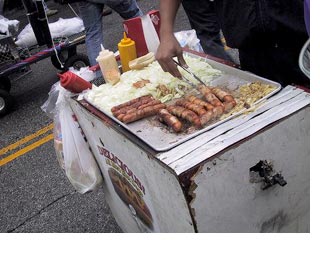 The proposed letter-grading ordinance has the support of most law-abiding food truck vendors, Powell said. Many of them have gone to great lengths to follow the county’s rules, which include obtaining public health department certification and operating out of officially-approved commissaries where they can dispose of wastewater and properly clean their vehicles
The proposed letter-grading ordinance has the support of most law-abiding food truck vendors, Powell said. Many of them have gone to great lengths to follow the county’s rules, which include obtaining public health department certification and operating out of officially-approved commissaries where they can dispose of wastewater and properly clean their vehicles
“I think, in general, everybody bought into it,” Powell said. “Having the grade on the vehicles is an easy identifier for the public to discern which are legal and which are illegal,” he said.
Vendor fees paid to the county—which range from $695 a year for a full-fledged catering truck to $301 for a simple pushcart selling prepackaged items—would not initially change under the new county ordinance, but could be raised later if cost analysis studies show an increase is warranted to cover the cost of the program. Health officials said they may be carrying out more inspections under the new system because they’ll be able to more easily locate the roving food-sellers, who would now be required to report their routes to the county. Like the restaurant-grading system, the new measure also would need approval by individual cities within the county.
Molly Taylor, whose Sweets Truck offers an array of upscale goodies to customers around town, said she supports the proposed grading system.
“I think a letter grade is great. My truck is cleaned every day from top to bottom,” Taylor said. She admits to some trepidation about new layers of bureaucracy coming not just from the county but from the city of Los Angeles, where new regulations also are being considered. But “hopefully, it will be for the greater good,” she said.
So popular is the food truck boom that some brick-and-mortar eateries are getting in on the act as well. And there, too, operators see the upside of doing business by the letters.
Bonnie Bloomgarden, who runs the Canter’s Truck, a mobile offshoot of the famed Fairfax Avenue deli, said the grades could be a helpful development in public education about the food-on-the-go industry.
“I think a lot of people still don’t understand that trucks have the same standards as a restaurant,” Bloomgarden said. “We pay rent, we pay taxes, we get inspected all the time. This is a way for people to know that our standards are high.”
Posted 9/14/10
Updated 10/12/10: The dining public is about to find out which local food trucks make the grade—literally.
The Los Angeles County Board of Supervisors today voted to extend the county’s successful and highly popular restaurant-grading system to mobile food vendors. The new ordinance amending the county code will apply first to 6,000 or so food trucks, and eventually will cover some 3,500 food carts, too.
For the new food truck ordinance to take hold countywide, local cities will need to sign on as well. Widespread participation is expected from the cities, which have overwhelmingly passed ordinances adopting the restaurant-grading system.
Terrance A. Powell, director of the public health department’s Bureau of Specialized Surveillance & Enforcement, Environmental Health Division, said the new regulations mark a major cultural shift in the food world.
“I think there is a realization now that mobile vending is a viable part of food service,” he said in an interview after the supervisors’ vote. “You don’t hear people refer to them as ‘roach coaches’ anymore.”
If adopted by supervisors on a second reading next week, the food truck ordinance will take effect in 30 days.
Updated 10/7/10: Supervisors on Tuesday, October 12, are expected to vote on this revised ordinance to post letter grades on food trucks.
Homeboy gets an intervention
September 14, 2010
The famed Homeboy Industries—dedicated to giving gang members an alternative to street life—has been given a helping hand to navigate its own future.
The Board of Supervisors on Tuesday approved a $1.3 million contract with the financially ailing Homeboy Industries to provide job training, counseling and tattoo removal for gang members seeking new lives. Earlier this year, faced with a $5 million shortfall, Homeboy was forced to layoff hundreds of staffers.
“This will be an enormous help,” said Father Greg Boyle, the Jesuit priest who founded Homeboy Industries, the nation’s largest gang-intervention program. “It helps us keep the doors open and continue to offer hope.”
In May, Boyle was forced to slash staffing from 427 to about 100 because of a crippling money crunch brought on by the recession, an expanding clientele and the organization’s costly expansion in 2007 to a new Chinatown headquarters.
Despite the cutbacks, Boyle kept open Homeboy’s bakery, café and other businesses. But he was forced to call on volunteers to perform services crucial to the program’s broader mission, such as counseling, mental health assistance and tattoo removal.
Founded in 1992 in Boyle Heights, Homeboy Industries’ slogan is: “Nothing stops a bullet like a job.” The organization says it helps 12,000 gang members yearly with educational, mental health, legal and job-training services. It runs five businesses, including Homeboy Bakery, Homegirl Café, as well as a silk-screen and embroidery shop and a janitorial and maintenance company.
Boyle said the county contract is recognition of the important role Homeboy plays in guiding Los Angeles gang members along the road from incarceration to independence.
“It’s really heartening and gratifying that the county has confidence in us,” said Boyle, whose recently published memoir is called “Tattoos on the Heart: The Power of Boundless Compassion.”
“The county,” he said, “has never asked us to be the after-care and re-entry program for gang members, but that’s what we’ve been.”
Since Homeboy’s highly publicized layoffs, the organization says it has raised $4.3 million in donations from foundations and individuals. As a result, staff levels rose to about 200 during the summer and included Homeboy’s executive team. Boyle said Homeboy has a $9.5 million budget, with revenues from its businesses totaling $3.5 million.
Still, Mona Hobson, Homeboy Industries’ director of development, said the organization isn’t out of danger. She said Homeboy must raise $13.3 million by the end of 2011 to cover expenses and establish a $2 million reserve fund for the first time. Hobson said that means Homeboy needs to raise roughly $7.5 million more.
The new L.A. County contract, which runs through June 2011, will fund, among other things, tattoo removal, job counseling and development and mental health services for 665 probationers and other high-risk individuals between the ages of 14 and 30. In addition, it will pay 20 trainees to work at Homeboy businesses.
Supervisors approved the contract 3-0. Supervisors Mark Ridley-Thomas and Michael D. Antonovich were absent for the vote.
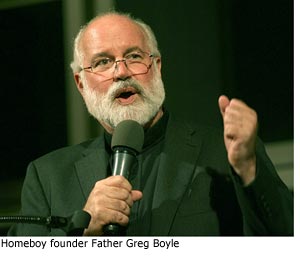 Boyle said Homeboy negotiators sparred with the county over a few key points. The county initially wanted the funding used exclusively for clients referred to Homeboy by the Probation Department. But Boyle made the argument that a client who voluntarily seeks the organization’s services may be more motivated than someone who is compelled to participate.
Boyle said Homeboy negotiators sparred with the county over a few key points. The county initially wanted the funding used exclusively for clients referred to Homeboy by the Probation Department. But Boyle made the argument that a client who voluntarily seeks the organization’s services may be more motivated than someone who is compelled to participate.
The two sides agreed that the funding would support a mix of referrals and walk-ins.
Homeboy officials also opposed a request that services be pre-approved by county officials—a fee-for-service arrangement that Boyle argued could cause harmful delays and deter clients.
“If a client comes in and says he wants mental health counseling, we want to provide it right away,” Boyle said. “He may not come back later. Why would you put up obstacles?”
Homeboy has had state, city and county contracts in the past, mostly for pilot programs that are separate from the core services that will be supported by its new pact with the county.
The “reentry grant” contract, as it’s called, will provide funding to cover portions of salaries for 17 existing staffers, including case managers, job developers, mentors and three mental health therapists.
Under the contract, Veronica Vargas, Homeboy’s chief operating officer, will become the project director. Homeboy’s current director of case management, Mario Prietto, will serve as program manager.
The contract also provides $100,000 to fund two UCLA scholars from the School of Public Affairs to evaluate the program’s outcomes. The researchers have been studying Homeboy for two years under a private grant. They’ll keep track of clients’ attendance, retention and re-incarceration rates, comparing them to other county programs aimed at similar populations.
Vargas said that Homeboy welcomes the scrutiny.
“We want to prove that we are a national model,” she said. “We’re very cost effective. A dollar goes a long way at Homeboy.”
Click here for a short documentary on Homeboy Industries.
Posted 9-14-10
Big step on subway’s long journey
September 10, 2010
And away we go.
After years of public meetings and study, the long-standing effort to bring a subway to the Westside of Los Angeles passed a key milestone today, with the release of a draft environmental impact statement spelling out potential routes to carry riders from the Mid-City area to Westwood.
The subway, an extension of Metro’s Purple Line and potentially the Red Line as well, will become a faster-moving transit alternative as traffic gridlock worsens in coming years, according to an executive summary accompanying the project’s Draft Environmental Impact Statement/Environmental Impact Report.
In justifying the need for the new subway, the report paints a grim picture of what the future might look like without one. By 2035, it projects 51,000 new residents and 58,000 new jobs in the area closest to the proposed subway. And that means more cars on clogged roadways and more people packed into buses, resulting in even slower commute times. Buses would slog along at 8 to 11 miles per hour and would add 29% more riders by 2035, the report said.
Even with the coming of the subway, the report promises very little in the way of easing roadway congestion. “The subway is not a silver bullet to cure all the traffic problems on the Westside,” said Metro spokesman Dave Sotero. But, he said, when combined with other improvements, it will offer a “fast, clean, reliable alternative to driving in traffic.”
Metro’s blog The Source did the math and found that what’s now a 54-minute cross-town odyssey from Union Station to Westwood using public transportation would become a 25-minute trip once the subway is built.
The subway also promises to open up a world of Westside offerings—from jobs to education to entertainment and culture—for people across the region.
The draft plan made public today sets out five possible routes for the subway. One begins at Western and moves west along Wilshire, stopping at stations at La Brea, Fairfax, La Cienega, Rodeo Drive, Century City and Westwood/UCLA. Another adds a station at the Westwood VA Hospital. Another goes further, running along Wilshire all the way to 4th Street in Santa Monica. Other alternatives would add stations in West Hollywood near the Beverly Center and along Santa Monica Boulevard, and would provide connections to the San Fernando Valley via the Red Line.
Some key decisions still must be made, however, including whether to build a station at Crenshaw and Wilshire, and where precisely to place many of the stations.
The public is invited to comment on the draft EIS/EIR in a series of meetings beginning later this month. The first will be held from 6-8 p.m. at LACMA on Sept. 20. A complete list of meetings and locations is here.
After a 45-day public comment period, the Metropolitan Transportation Authority’s board will decide at its Oct. 28 meeting whether to approve the draft report along with a “locally preferred” alignment. Then work will get underway on a final environmental report for the project, along with preliminary design work.
Depending on which route is selected, the project could cost from $4 billion to $8.7 billion, the report said. Getting the subway as far as Westwood could be funded with revenues from Measure R, the half-cent sales tax approved by voters in 2008, along with anticipated federal matching funds. Adding the West Hollywood or Santa Monica leg would require finding additional funding sources.
The federal government also is being asked to help accelerate the pace of building the subway under the 30/10 Initiative, in which local leaders are seeking to borrow against future Measure R revenues in order to fast-track major transit projects in the region. The infusion of federal dollars could allow the projects to be completed in 10 years, instead of 30.
Posted 9/03/10
She’s got a ticket to ride
September 10, 2010
Ever since Faye Kingslee moved to Los Angeles about six months ago, public transportation has been more than just a ride for the aspiring actress.
It’s been a rolling office, a mobile dressing room to put on makeup before auditions and a source of endless creative inspiration provided by a colorful, ever-changing cast of fellow riders.
Now public transportation is taking Kingslee on another kind of ride. Her short video, “The Heartbeat of LA,” just won top honors in Metro’s Transit Flicks Video Contest.
The win means more than just a free one-year EZ transit pass for Kingslee, an Australia native who has lived and worked all over the world, from Singapore to New York. It also was a chance to bring her favorite kind of storytelling to a new audience.
And, it turns out, an opportunity to introduce her volunteer cast and crew to the joys of mass transit.
“All the people who I brought on to work on this project with me had never been on the train before,” Kingslee said. She described the 6 a.m. to 9 a.m. shoot, aboard a Metro Red Line train traveling between Union Station and North Hollywood, as a “really guerilla style” operation.
The 2-minute film depicts a sweet, silent encounter between two subway passengers—Kingslee and fellow actor Bryson Kuan—that looks like it just might blossom into something bigger.
Like other films turned out by Kingslee’s ShortFilmsWeekend collective—a nonprofit that brings together various volunteer craftspeople to create movies seen on YouTube—her inspiration came from what she sees around her, often on the bus or train.
“It randomly happens sometimes,” she said. “You can have connections and moments with people.”
Her concept, turned into a script by Alix Reeves and directed by David Redish, was selected over six other finalists, winning 26.58% of 1,000-plus votes cast by the public in the contest.
Kingslee, who aspires one day to have her own production house, lives in Hollywood and usually rides her skateboard to get to her Red Line stop. “I’ve actually been high-fived” rolling along Hollywood Boulevard, she said.
And six months in L.A. haven’t changed her original decision to live car-free.
“I’m still sticking with public transit,” she said. “I still don’t have a car. It’s a way of life.”
Posted 9/10/10
Got West Nile fears? Go fish
September 9, 2010
 Dead birds, slimy abandoned swimming pools and bloody-thirsty mosquitoes might sound like plot elements from a B horror movie. But they’re all possible harbingers of a real-life hazard in our midst—the West Nile virus.
Dead birds, slimy abandoned swimming pools and bloody-thirsty mosquitoes might sound like plot elements from a B horror movie. But they’re all possible harbingers of a real-life hazard in our midst—the West Nile virus.
Fortunately, there’s a real-life weapon against the pesky insects, which can spread West Nile to humans after feeding on birds infected with the virus. That’s the mosquitofish, a.k.a. Gambusia affinis, which makes a meal out of mosquito larvae before they can grow up to make a meal out of us. Mosquitoes are more than just a backyard annoyance; in addition to West Nile, they can spread various strains of encephalitis and other diseases to humans.
And, because of the surge in home foreclosures in recent years, mosquitoes have found a new Southern California breeding ground—abandoned swimming pools. While the impact of these pools on the mosquito population can’t be quantified, “home foreclosures are definitely a factor,” said Crystal Brown, public information officer for the Greater Los Angeles County Vector Control District.
The fish are an effective, non-chemical way to keep mosquitoes from proliferating in garden ponds, animal drinking troughs and other standing water sources. Brown said that since 2005, more than 1,200 requests for the free fish have poured in to her district—one of five in the county. The fish should never be placed in natural habitats such as creeks and streams, or in drainage culverts that lead to waterways, however, because of harm they could cause to wildlife there. (Read up on the proper use of mosquitofish here.)
Overall, West Nile activity so far this year has been slower than last year, perhaps partly because of a cooler-than-usual summer.
But public health officials say this season’s first human case recently was confirmed in a Los Angeles County teenager, pointing up the need to be aware of the symptoms and vigilant about potential mosquito breeding grounds. The teenager, from the eastern part of the county, has recovered.
Most mosquitoes don’t carry the virus, and fewer than 1 in 150 people who are bitten by an infected mosquito go on to become seriously ill. But for those who do, “it isn’t a pleasant disease,” said Dr. David E. Dassey, deputy chief of Acute Communicable Disease Control for the public health department. “The problem comes in older individuals who have other chronic medical conditions.”
The vast majority of others experience only mild symptoms—which can include fever, headache, nausea, body aches and skin rashes—or none at all. They also come away with lifelong immunity to the virus.
To be on the safe side, Dr. Jonathan E. Fielding, the county’s director of Public Health, recommends using an insect repellant containing DEET when outside in mosquito-prone areas, particularly at dawn or dusk.
In addition, the county Public Health Department’s Environmental Health Bureau encourages anyone who spots a “green pool” to report it by calling (626) 430-5200. And because mosquitoes pick up the disease from infected birds, health officials are asking the public to promptly call the state’s “Dead Bird Hotline” if they spot a bird carcass. The number is (877) 968-2473. Reports also can be filed online.
The West Vector and Vector-Borne Disease Control District, covering the Third Supervisorial District, has a helpful website with questions and answers about West Nile, along with useful links and phone numbers, including one for requesting those free mosquitofish. Call (310) 915-7370 for information on when and where to pick them up.
And keep in mind that this is strictly a BYOB operation—meaning bring your own bucket.
Posted 9/9/10







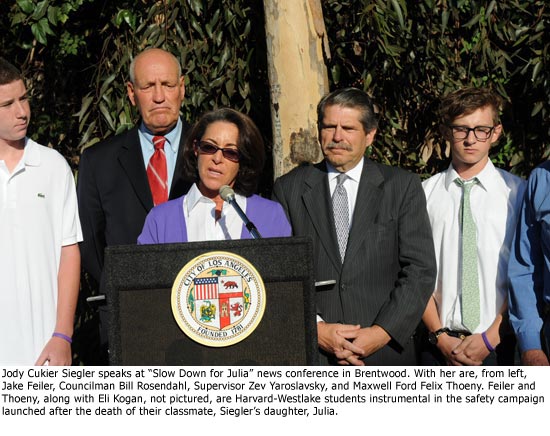
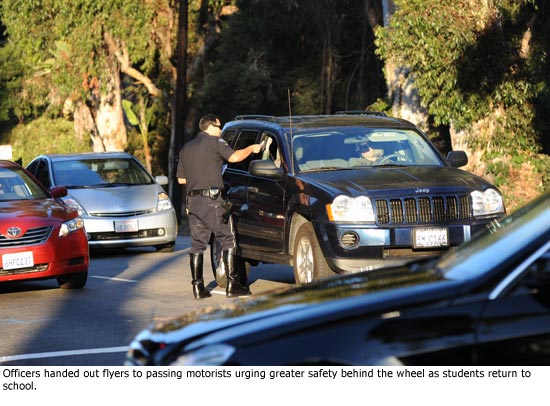
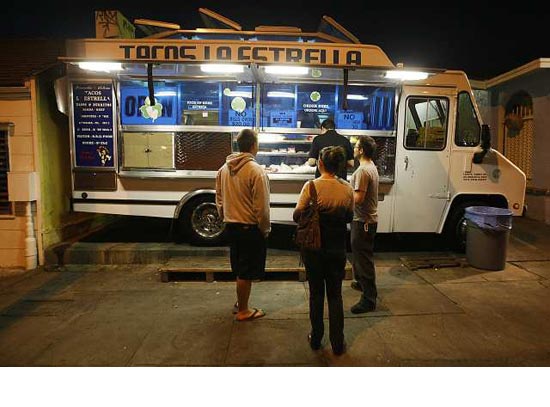
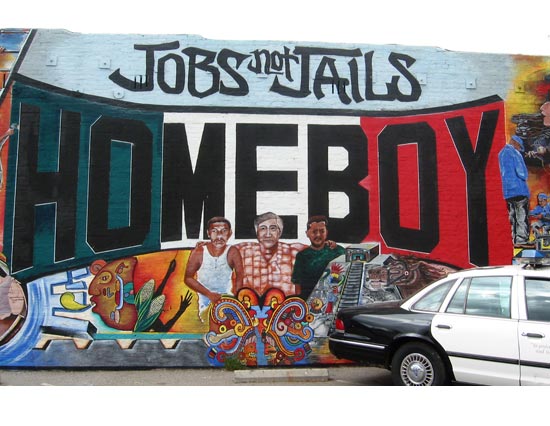

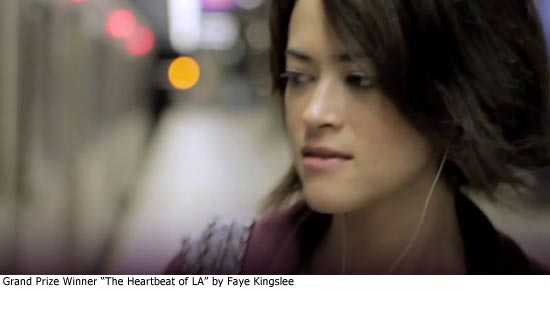





 Check for the latest closure information
Check for the latest closure information








